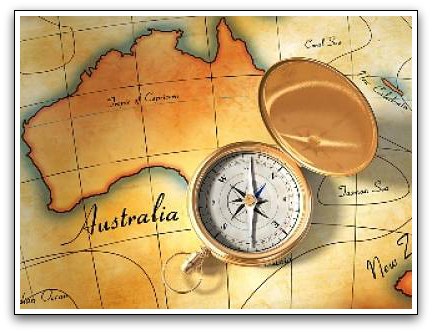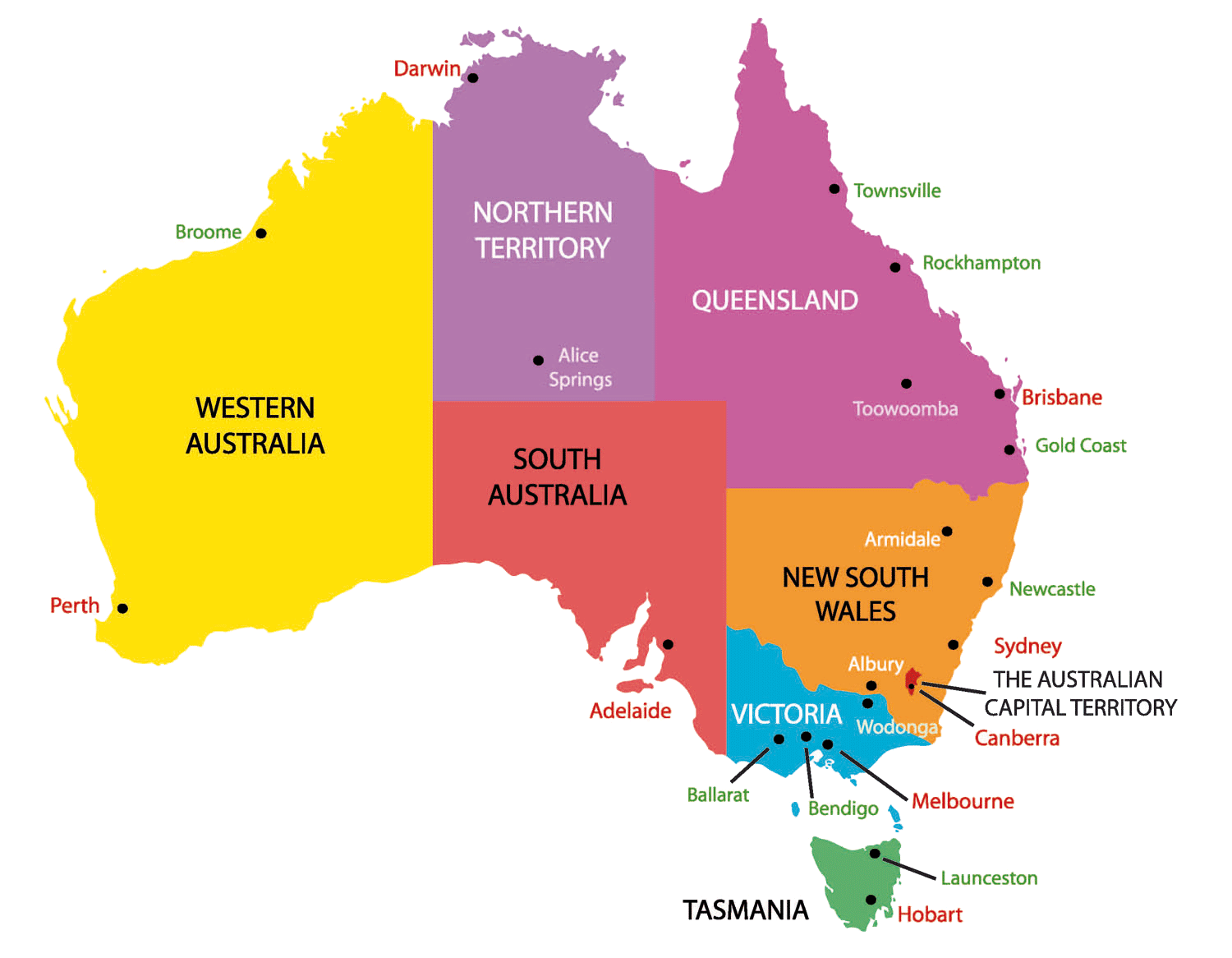Australia

Australia is the sixth-largest country by land area. Australia is bordered to the west by the Indian Ocean, and to the east by the South Pacific Ocean. The Tasman Sea lies to the southeast, separating it from New Zealand, while the Coral Sea lies to the northeast. Papua New Guinea, East Timor and Indonesia are Australia’s northern neighbors, separated from Australia by the Arafura Sea and the Timor Sea.
Australia is highly urbanized with most of the population heavily concentrated along the eastern and south-eastern coasts. Most of the inland areas of the country are semi-arid. The most-populous states are Victoria and New South Wales, but by far the largest in land area is Western Australia.
Australia has an area of 7,682,300km² (2,966,152 square miles) and the distances between cities and towns are easy to underestimate.
Australia has large areas that have been deforested for agricultural purposes, but many native forest areas survive in extensive national parks and other undeveloped areas. Long-term Australian concerns include salinity, pollution, loss of biodiversity, and management and conservation of coastal areas, especially the Great Barrier Reef.
Indigenous and Australian people
Before the arrival of British colonizers in 1788, Australia was inhabited by the Indigenous peoples – Aborigines and Torres Strait Islanders, sometimes referred to as the First Australians. Aboriginal people inhabited the whole of Australia and Torres Strait Islanders lived on the islands between Australia and Papua New Guinea, in what is now called the Torres Strait. Today, Indigenous people make up 2.4 per cent of the total Australian population (about 460,000 out of 22 million people).
Australia is one of the most ethnically diverse societies in the world. Almost one in four Australian residents were born outside of Australia and many more are first or second generation Australians, the children and grandchildren of recently arrived migrants and refugees. These wide varieties of backgrounds, together with the culture of Indigenous Australians who have lived on the Australian continent for more than 50,000 years, have helped create a uniquely Australian identity and spirit. There were over 500 different clan groups or ‘nations’ around the continent, many with distinctive cultures, beliefs and languages.
Source: https://www.australia.gov.au/about-australia/our-country/our-people

Government and Policies
Australia is a federal parliamentary constitutional monarchy with the Queen Elizabeth II at its apex as the Queen of Australia, a rote that is distinct from her position as monarch of the other Commonwealth realms. The Queen is represented in Australia by Governor – General at the federal level and by the Governors at the state level who by convention act on the advice of her ministers
Australia has six states and two major mainland territories. In each state has its own state constitution, which divides the state’s government into the same divisions of legislature, executive, and judiciary as the federal government. With two major mainland territories, they have been granted a limited right of self-government by the federal government. In these territories, a range of governmental matters are handled by a locally-elected parliament.
State and Territories
New South Wales (NSW)
New South Wales is a state on the east coast of Australia. It borders Queensland to the north, Victoria to the south and South Australia to the west. The state capital is Sydney which is Australia’s most populous city. Many tourists come to New South Wales to visit the city of Sydney and its attractions, for example, the Sydney Opera House and the Sydney Harbour Bridge, two of the most iconic structures on this planet.

Victoria (VIC)
Victoria is the southernmost of the eastern mainland state of Australia with New South Wales lies to the north / north-east while South Australia lies to the west and the southern coast. The capital city of the state is Melbourne where is the world’s most liveable city for seventh year running by The Economist Intelligence Unit’s. Beside this, Melbourne is also famous as the host city for a range of major international sporting events such as the Australian Open, Melbourne Cup Carnival and Formula 1 Grand Prix.

Western Australia (WA)
Western Australia is the largest state in Australia, occupying the western third of the continent. Perth is the capital city of Western Australia and the fourth large city of Australia. Perth sprawls along a flat coastal plain, centered along the Swan River and bounder by the Darling Scarp to the east and the Indian Ocean Coastline in the west
Queensland (QLD)
Queensland is one of the six states in Australia and probably most famous because of its association with several major world heritage sites including the Great Barrier Reef and the Daintree National Park. The capital city of the state is Brisbane, the third largest city of Australia, while the other major tourist areas is the beach – based tourist resort in the south of Brisbane, known as the Gold Coast.
South Australia (SA)
South Australia is a state of Australia in the south of the country between Western Australia to the west and Queensland, New South Wales and Victoria to the east, and south of Northern Territory. Adelaide is the state’s capital. South Australia is the home of some of Australia’s best wines, the Barossa Valley, the McLaren Vale and the lesser-known Clare Valleys are the reason why many travel to South Australia.
Tasmania (TAS)
Tasmania is Australia’s only island state. It has the smallest lad area of any state and the smallest population. It is separated from the Australia mainland by a body of water called the Bass Strait that has isolated it for thousands of years. Hobart is the capital city of Australian State of Tasmania. Hobart is small and intimate compared to larger mainland Australian cities, reflecting the small size of the state. The metropolitan area stretches north and south along the Derwent River, crossed by several bridges.
Australian Capital Territory (ACT)
Canberra is the capital city of Australia. The city is located in the Australian Capital Territory, an enclave in the south-east of New South Wales. Canberra is a planned city, with national monuments, museums and galleries built around a large artificial lake. As a bush capital, Canberra is also a great place to enjoy the outdoors, with excellent cycling, gardens, parks, and bushwalking and nature reserves.

Northern Territory (NT)
Darwin is a small yet cosmopolitan city. People from more than 50 nations make up its population of 110,000. It is on the Timor Sea (a branch of the Indian Ocean) in north-central Australia. Darwin is the tropical capital city of the Northern Territory.
Source: Wikitravel
Australian Education
Australia has a national curriculum which provides schools, teachers, parents, students and the community with a clear understanding of what students should learn, regardless of where they live or what school system they are in. Anyway, State, Territory and non government education authorities are responsible for delivering the Australian Curriculum, including decisions about implementation timeframes, classroom practices and resources that complement teaching of the Australian Curriculum.

With the Australian education system can be divided in School education and Tertiary Education. For School education, it is similar across all of Australia with only minor variations between states and territories. School education is 13 years can be divided into
- Primary school : start from Kindergarten / Preparatory though to Year 6 or 7
- Secondary School : from Year 7 to 10 or Year 8 to 10
- Senior Secondary School : runs for two years from Year 11 and 12
For Tertiary Education includes both higher education in universities and vocational education and training runs though Technical and Further Education (TAFE). With study in higher education courses, it can be taken to earn an advanced degree and continue studies in Australia. There are three main types of higher education which lead to Bachelor, Master and Doctoral Degree.

There are 43 universities in Australia with 40 Australian universities, two international universities, and one private specialty university. Along with the universities, many other institutes offer higher education course with wide range of areas from science to management and commerce, humanities to engineering, and law to health science. Australian institutions rank among the world’s best by discipline, particularly in engineering and technology, medicine, environmental science, and accounting and finance.
Source: https://www.studyinaustralia.gov.au/english/australian-education/education-system

Australian Dollar
Australia’s national currency is the Australian dollar (A$ or AU$) which comes in denominations of $5, $10, $20, $50 and $100 banknotes. Coins come in 5, 10, 20 and 50 cent and $1 and $2 dollar denominations.

Electricity and Water in Australia
In Australia the standard voltage is 230 V and the frequency is 50 Hz as similar as in Thailand. However, the power sockets are different. The plug has two flat 1.6 mm thick blades, set at 30° to the vertical, forming an upside-down V shape.
In Australia, tap water is drinkable. However it needs to be boiled in order to drink warm water.
Public Transportation in Australia
All of Australia’s major towns have reliable, affordable public bus networks, and suburban train lines in Sydney, Melbourne, Brisbane, Adelaide and Perth. The other public transportation like ferries are available in Sydney and Brisbane, while tram is one of major public transportation in Melbourne.

source: https://www.lonelyplanet.com/australia/transport/getting-around/local-transport







